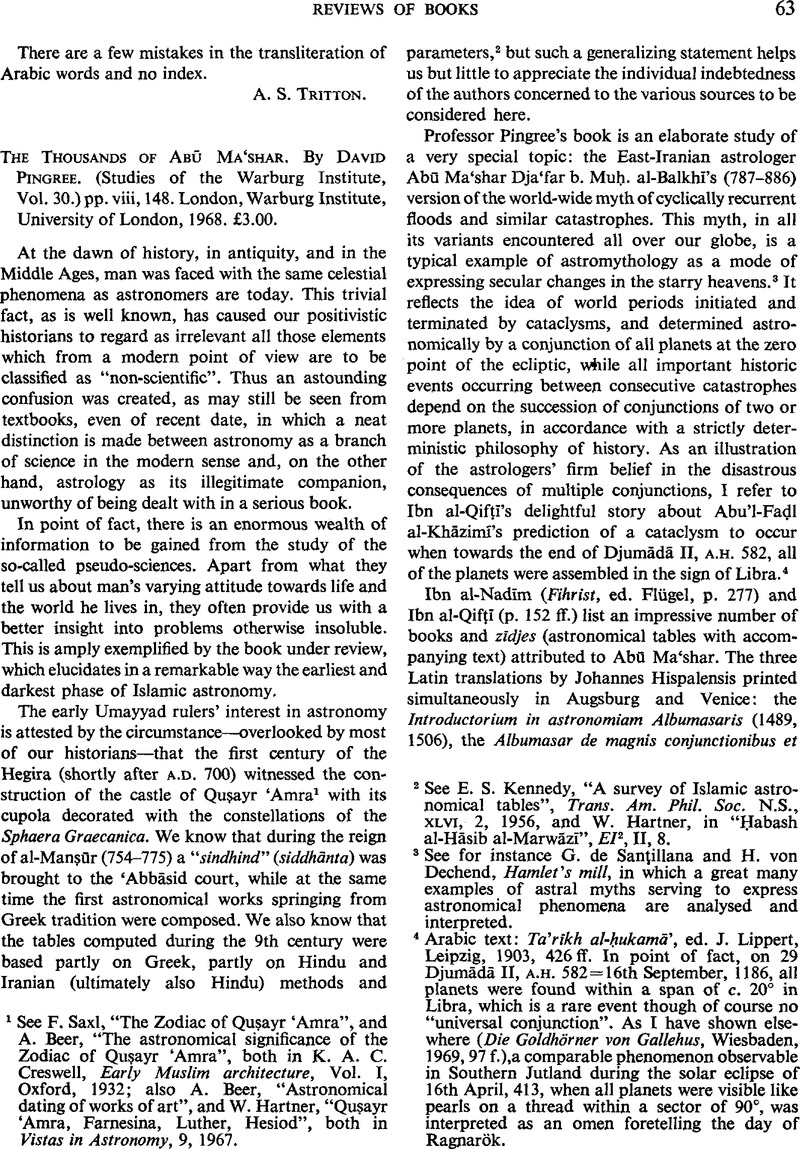No CrossRef data available.
Article contents
The Thousands of Abū Ma‘shar. By David Pingree. (Studies of the Warburg Institute, Vol. 30.) pp. viii, 148. London, Warburg Institute, University of London, 1968. £3.00.
Published online by Cambridge University Press: 15 March 2011
Abstract

- Type
- Reviews of Books
- Information
- Copyright
- Copyright © The Royal Asiatic Society 1972
References
1 See Saxl, F., “The Zodiac of Quṣayr ‘Amra”, and A. Beer, “The astronomical significance of the Zodiac of Quṣayr ‘Amra”, both in Creswell, K. A. C., Early Muslim architecture, Vol. I, Oxford, 1932Google Scholar; also Beer, A., “Astronomical dating of works of art”, and W. Hartner, “Quṣayr ‘Amra, Farnesina, Luther, Hesiod”, both in Vistas in Astronomy, 9, 1967.Google Scholar
2 See Kennedy, E. S., “A survey of Islamic astronomical tables”, Trans. Am. Phil. Soc. N.S., XLVI, 2, 1956Google Scholar, and Hartner, W., in “Ḥabash al-Hāsib al-Marwāzi”, EI2, II, 8.Google Scholar
3 See for instance G. de Sanṭiliana and H. von Dechend, Hamlet's mill, in which a great many examples of astral myths serving to express astronomical phenomena are analysed and interpreted.
4 Arabic text: Ta'rikh al-ḥukamā’, ed. Lippert, J., Leipzig, 1903, 426Google Scholar ff. In point of fact, on 29 Djumādā II, a.h. 582 = 16th September, 1186, all planets were found within a span of c. 20° in Libra, which is a rare event though of course no “universal conjunction”. As I have shown elsewhere (Die Goldhörner von Gallehus, Wiesbaden, 1969, 97 f.)Google Scholar, a comparable phenomenon observable in Southern Jutland during the solar eclipse of 16th April, 413, when all planets were visible like pearls on a thread within a sector of 90°, was interpreted as an omen foretelling the day of Ragnarök.
5 B.N. MS ar. 2581, a treatise by al-Sidjzī (see below) based in part on Abū Ma‘shar's K. al-ulūf (see the book under review, pp. 70 ff.), carries the title K. al-qirānāt wa-taḥāwīl sinī al-‘ālam, in which the titles of two books by Abū Ma‘shar listed separately in the Fihrist are combined. Curiously, the same combination occurs in the Latin title “Albumasar de magnis conjunctionibus et annorum revolutionibus”.
6 Albumasaris De revolutionibus nativitatum, Leipzig (Bibl. Teubneriana), 1968.Google Scholar
7 The Fihrist and Qifṭī have iḥtirāfāt, while Pingree reads ikhtirāqāt (2, n. 3). The correct reading of the term, undoubtedly, is iḥtirāq “combustion”, indicating the moment at which a planet is sufficiently close to, but more than 16′ distant from, the Sun before conjunction; cf. the Mafātīḥ al-‘Ulūm, ed. van Vloten, , Leiden, 1895, 224Google Scholar, moreover al-Bīrūnī, The book of instruction in the elements of the art of astrology, ed. and tr. Wright, R. Ramsay, London, 1934, 64 and 317Google Scholar, and Bouché-Leclercq, A., L' Astrologie grecque, Paris, 1899, 112, n. 1Google Scholar. Also on p. 76, it seems certain that iḥtirāq, not ikhtirāq, “crossing”, is meant.
8 Pingree assumes that al-Zidj al-kabīr and al-Zīdj al-ṣaghir (“ which is known as the Zidj al-qirānāt”, cited after Qifṭī) are erroneously listed by Qifṭī as independent works and that Abū Ma‘shar actually composed only two zīdjes.
9 JAOS, 83, 3, 1963, 315–27.
10 See Houzeau-Lancaster, , Bibliographie générale de l'astronomie jusqu'en 1880, Vol. I, Brussels, 1880 (repr. London, 1964)Google Scholar, p. 704, no. 3831, where this MS is described as a “version latine d'un texte arabe”.




